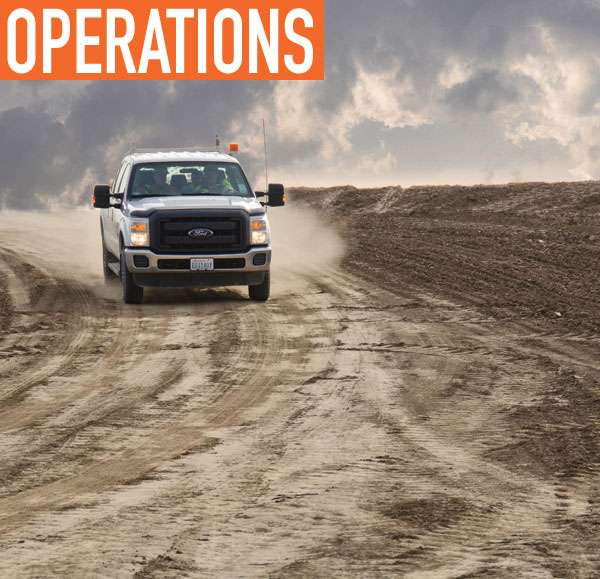Senior managers at Goodfellow Brothers Inc. face a geographical challenge like few others in their profession. They must coordinate the activities of fleet operations and several maintenance shops separated by more than 2,500 miles of Pacific Ocean, spread out over a vast area that includes three time zones.
The fourth-generation family-owned company operates a fleet of 1,200 vehicles and earth-moving equipment on several project sites in Hawaii, Oregon, and Washington. The company works on a variety of different construction projects, including airport runways and taxiways, bridges and other road transportation projects, marinas, and site preparation for housing and business developments.
Coordinating the maintenance and operations of the equipment over the company’s huge territory is the responsibility of a small group of Goodfellow Brothers managers at the company’s headquarters in Wenatchee, Washington.
“The group has always successfully managed the fleet operations, maintaining safety awareness and keeping on top of equipment and truck repairs,” says Richard Kornmann, visual inspection analyst for Goodfellow Brothers.
“Still, we knew we could do better. We suspected that we had problems with excessive weekend vehicle usage and idling; as well as with illegible, incomplete, and inconsistent vehicle inspection reports. We also had drivers speeding to and from worksites—and through them—to get to work, to stay on schedule, or to finish their assignments. Without some way of measuring what was happening, we really had no idea about the extent of these issues, and we certainly couldn’t hold our employees accountable for things we weren’t tracking.”
Starting in 2010, Goodfellow Brothers’ managers turned to Zonar for answers. They implemented a four-phased telematics project to improve the safety and efficiency of the company’s fleet operations.
The first phase involved equipping the company’s fleet of about 450 pickup trucks with Zonar’s telematics system, then monitoring usage through the company’s web application. During the second phase, which started a year later, the company outfitted its construction vehicles—including dump trucks and about 650 earth-moving units—with the telematics system and its electronic vehicle inspection reporting (EVIR) system. The third phase involved monitoring the fuel usage and emissions of its rock crushers. During the fourth phase, the company provided suppliers with portable telematics devices to get a more complete view of its worksites.

Featured Image: Goodfellow Brothers implemented a four-phased telematics project to improve the safety and efficiency of the company’s fleet operations. The first phase involved equipping the company’s fleet of about 450 pickup trucks with Zonar’s telematics to monitor usage.
Above: Richard Kornmann, visual inspection analyst for Goodfellow Brothers, checks the connection to the Zonar V3R telematics unit, which features a newer generation of wireless technology than the company’s previous units.
FUEL SAVINGS
“During the first phase, we monitored how pickup trucks were driven and operated, then used the information in a training program to counsel drivers,” says Kornmann.
Within a year, Goodfellow Brothers achieved an immediate drop in weekend vehicle usage, speeding, and idling. Pickup drivers no longer left their engines running while stopped at jobsites. By cutting the incidences of idling in half, the company realized an annual savings of about $54,000 in fuel costs.
“In the reports generated by Zonar, the amount of time each truck spent idling surprised us all, particularly the drivers,” says Kornmann. “Before implementing Zonar, it wasn’t uncommon for us to see our trucks and equipment burn as much as $600 worth of fuel each week just idling.
“After implementing Zonar and providing drivers counseling on how to reduce their idling, we saw the amount of fuel burned due to idling reduce to $160-$180 per week. Now it’s rare if we break $100 per week in fuel costs due to idling, and that’s usually on account of traffic. And incidences of speeding are practically nil.”
While the reduction in annual fuel expenses more than paid for the cost of implementing the system, Goodfellow Brothers managers say success with the telematics project’s second phase is what really paid off for the company.
During the second phase, Goodfellow Brothers established its two-tier program that indicates the severity and importance of issues discovered by vehicle and equipment operators during their pre- and post-trip inspections. The alerts also prioritize issues reported by onboard equipment, vehicle sensors and computers, such as engine performance.
 Using Zonar’s 2020 tablet, Goodfellow Brothers equipment and vehicle operators conduct their inspections by placing the reader within inches of each tag. When a defect is discovered, the operator selects a description from a predefined list and indicates if the defect warrants a yellow or red alert, unless the condition is preset as a red alert.
Using Zonar’s 2020 tablet, Goodfellow Brothers equipment and vehicle operators conduct their inspections by placing the reader within inches of each tag. When a defect is discovered, the operator selects a description from a predefined list and indicates if the defect warrants a yellow or red alert, unless the condition is preset as a red alert.
SHOP EFFICIENCIES
“Any issue or problem that could inflict injury or endanger the lives of our employees or others, or lead to further damage to a machine is considered a red alert,” says John Stump, equipment department manager for Goodfellow Brothers. “Yellow alerts are for issues that should be addressed but don’t require immediate attention.
“For example, if the operator reports that the back-up alarm isn’t working, that would be considered a red alert. Any equipment with a non-working back-up alarm would be taken out of service until it’s fixed.”
Stumps adds: “In many cases, particular problems, such as non-working back-up alarms, are already preset as red-alert issues in the system; however, the inspection application allows equipment or vehicle operators to reclassify yellow-alert issues with a higher red-alert priority when they deem the situation requires it, giving the operators more control.”
The alerts are immediately communicated back to the maintenance shops. Maintenance technicians can then schedule the repair when the vehicle returns to the shop or assign a remote service repair truck if the vehicle or equipment can’t be driven or moved. Red alerts are also communicated to dispatchers and the company’s headquarters, notifying senior company managers. The senior managers follow up a few days later to see if the local maintenance shop has completed the repair or needs more resources.
Stump says this two-tier alert system, utilizing EVIR and the telematics systems, helped his company significantly increase the amount of scheduled work the company’s seven maintenance shops can complete in a week. By using telematics, drivers can identify potential maintenance issues so they can be addressed long before they cause equipment breakdowns or become unscheduled work, which can slow or even stop progress at jobsites.
“We’ve been able to achieve better than the industry standard of 65 percent efficiency at our maintenance shop in Maui and 55-60 percent efficiency at our other locations with the information we get from Zonar,” says Stump. “Shop efficiency is measured in how much-scheduled work gets done each week, so 65 percent efficiency means the shop has completed 65 percent of its scheduled work.”

OTHER ADVANTAGES
For the telematics program’s third phase, Goodfellow Brothers added RFID tags to its crushing equipment. When the crushing equipment gets refueled, employees can scan the RFID tags and report the amount of fuel they put into the machines and the number of hours the machines have been in operation. This allows managers to closely monitor fuel usage and emissions. Weight scales were also added to the crushing belts to measure tons per hour.
For the program’s fourth phase, Goodfellow Brothers provided trucking companies that haul equipment and supplies to and from its worksites with telematics units that plug into a cigarette lighter. These plug-and-play devices offer Goodfellow Brothers a more accurate look into what’s happening at the jobsites when supplies and equipment are delivered. Stump says managers can use the suppliers’ arrival and unloading times to gain additional jobsite efficiencies.
“We can see if suppliers and vendors are waiting to unload their equipment or supplies,” Stump says. “That can indicate to us that we have some scheduling problems or other delays on the jobsite that need to be addressed.”
Goodfellow Brothers management provides customers and regulatory agencies access to the detailed reports that telematics equipment offers. This lets customers and regulatory agencies know when crushing equipment is operated; when supplies and equipment are delivered; when trucks and other equipment are inspected; if there were any issues found; and how quickly those problems were fixed.
“We’ve found that regulators and customers appreciate the level of transparency this provides them,” Stump shares.
FOR MORE INFORMATION:
For more information, visit www.zonarsystems.com, or contact Lisa Bauder at lisa.bauder@zonarsystems.com.
_______________________________________________________________________
MODERN WORKTRUCK SOLUTIONS: OCtober 2015 Issue
Did you enjoy this article?
Subscribe to the FREE Digital Edition of Modern WorkTruck Solutions magazine.
![]()




